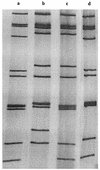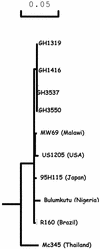Changing patterns of rotavirus genotypes in ghana: emergence of human rotavirus G9 as a major cause of diarrhea in children
- PMID: 12791843
- PMCID: PMC156506
- DOI: 10.1128/JCM.41.6.2317-2322.2003
Changing patterns of rotavirus genotypes in ghana: emergence of human rotavirus G9 as a major cause of diarrhea in children
Abstract
Genotyping of human rotaviruses was performed on 312 rotavirus-positive samples collected from 2,205 young children with diarrhea in the Upper East District of Ghana, a rural community. Of the 271 (86.9%) rotavirus strains that could be VP7 (G) or VP4 (P) characterized, 73 (26.9%) were of G9 specificity. The predominant G9 genotype was G9P[8], which constituted 79.5% of all G9 strains detected, followed by G9P[6] (12.3%), G9P[10] (2.7%), and G9P[4] (1.3%). G9 strains with mixed P types constituted 2.7% of all G9 strains found in the study. All the G9P[8] strains had a long RNA electrophoretic pattern with VP6 subgroup II specificity. Four G9 isolates, GH1319, GH1416, GH3550, and GH3574, which were selected based on the abundance of stool material and were representative of the three electropherotypes observed, were cloned and sequenced. The Ghanaian isolates shared more than 98% sequence nucleotide homology with other G9 strains from the United States (US1205), Malawi (MW69), Brazil (R160), Japan (95H115), and Nigeria (Bulumkutu). However, they showed only 95% nucleotide homology with the Thai G9 strain Mc345. Phylogenetic analysis of the nucleic acid sequence revealed the existence of at least three clusters, with Ghanaian strains forming one cluster, Nigerian and Brazilian strains forming a second cluster, and U.S., Malawian, and Japanese strains forming a third.
Figures


References
-
- Armah, G. E., J. A. Mingle, A. K. Dodoo, A. Anyanful, R. Antwi, J. Commey, and F. K. Nkrumah. 1994. Seasonality of rotavirus infection in Ghana. Ann. Trop. Paediatr. 14:223-229. - PubMed
-
- Armah, G. E., C. T. Pager, R. H. Asmah, F. R. Anto, A. R. Oduro, F. Binka, and A. D. Steele. 2001. Prevalence of unusual human rotavirus strains in Ghanaian children. J. Med. Virol. 63:67-71. - PubMed
-
- Bass, D. M. 2000. Rotavirus vaccinology: good news and bad news. J. Pediatr. Gastroenterol. Nutr. 30:10-11. - PubMed
-
- Bishop, R. F. 1996. Natural history of human rotavirus infection. Arch. Virol. Suppl. 12:119-128. - PubMed
Publication types
MeSH terms
Substances
Associated data
- Actions
- Actions
- Actions
- Actions
LinkOut - more resources
Full Text Sources
Medical

